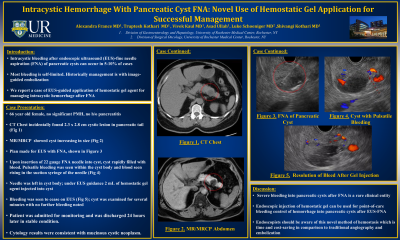Monday Poster Session
Category: Endoscopy Video Forum
P2175 - Intracystic Hemorrhage With Pancreatic Cyst FNA: Novel Use of Hemostatic Gel Application for Successful Management
Monday, October 28, 2024
10:30 AM - 4:00 PM ET
Location: Exhibit Hall E


Alexandra France, MD
University of Rochester Medical Center
Rochester, NY
Presenting Author(s)
Alexandra France, MD1, Truptesh Kothari, MD1, Vivek Kaul, MD1, Asad Ullah, MD1, Luke Schoeniger, MD1, Shivangi Kothari, MD2
1University of Rochester Medical Center, Rochester, NY; 2University of Rochester, Rochester, NY
Introduction: Intracystic bleeding after endoscopic ultrasound (EUS) guided fine needle aspiration (FNA) of pancreatic cysts is a rare complication, estimated to occur in 5-10% of patients. Many cases of bleeding are self-limited, however more severe cases traditionally have been managed with angiography and embolization. We report a case of EUS guided intracystic application of a novel self-assembling hemostatic peptide gel to manage intraprocedural post FNA bleeding.
Case Description/Methods: 66-year-old woman with no significant medical history was referred to our center for incidentally found 2.3 x 2.8 cms cystic lesion in the pancreatic tail. No prior history of pancreatitis and no referable symptoms. Interval magnetic resonance imaging / magnetic resonance cholangiopancreatography done after gastroenterology consultation revealed cyst to have grown in size to 3 cms. Decision was made to pursue EUS for further evaluation. EUS showed normal pancreatic parenchyma and 2.5 cm cyst with 5 mm mural nodule in the body-tail region of the pancreas. FNA was performed with a 22-gauge needle, with color doppler applied before needle puncture to check for blood vessels in the needle path. As soon as FNA was performed, real-time EUS imaging revealed active pulsatile bleeding noted within the cyst and aspirate was consistent with frank blood. 2 mL of hemostatic gel was injected through the FNA needle into the cyst, and bleeding was seen to cease on EUS. The cyst was closely observed for several minutes, and no recurrent bleeding was seen. The patient was admitted to the hospital post-procedure for monitoring, and was discharged 24 hours later with stable hemoglobin and hemodynamics. Cytology results were consistent with mucinous cystic neoplasm. Patient was referred to surgical oncology and subsequently underwent distal pancreatectomy.
Discussion: Severe bleeding into pancreatic cysts after EUS-guided FNA is a well-known but rare clinical entity. Endoscopic intracystic application of a novel hemostatic gelwas used for effective hemostasis of active, pulsatile bleeding in our patient. Real-time endoscopic management of intracystic bleeding would be a preferable approach as compared to traditional management with angiography and embolization, because it avoids the need for an additional procedure, and is both time and cost-saving. Endoscopists should be aware of this (off-label) option and consider its use in management of EUS-FNA associated intracystic bleeding.
Disclosures:
Alexandra France, MD1, Truptesh Kothari, MD1, Vivek Kaul, MD1, Asad Ullah, MD1, Luke Schoeniger, MD1, Shivangi Kothari, MD2. P2175 - Intracystic Hemorrhage With Pancreatic Cyst FNA: Novel Use of Hemostatic Gel Application for Successful Management, ACG 2024 Annual Scientific Meeting Abstracts. Philadelphia, PA: American College of Gastroenterology.
1University of Rochester Medical Center, Rochester, NY; 2University of Rochester, Rochester, NY
Introduction: Intracystic bleeding after endoscopic ultrasound (EUS) guided fine needle aspiration (FNA) of pancreatic cysts is a rare complication, estimated to occur in 5-10% of patients. Many cases of bleeding are self-limited, however more severe cases traditionally have been managed with angiography and embolization. We report a case of EUS guided intracystic application of a novel self-assembling hemostatic peptide gel to manage intraprocedural post FNA bleeding.
Case Description/Methods: 66-year-old woman with no significant medical history was referred to our center for incidentally found 2.3 x 2.8 cms cystic lesion in the pancreatic tail. No prior history of pancreatitis and no referable symptoms. Interval magnetic resonance imaging / magnetic resonance cholangiopancreatography done after gastroenterology consultation revealed cyst to have grown in size to 3 cms. Decision was made to pursue EUS for further evaluation. EUS showed normal pancreatic parenchyma and 2.5 cm cyst with 5 mm mural nodule in the body-tail region of the pancreas. FNA was performed with a 22-gauge needle, with color doppler applied before needle puncture to check for blood vessels in the needle path. As soon as FNA was performed, real-time EUS imaging revealed active pulsatile bleeding noted within the cyst and aspirate was consistent with frank blood. 2 mL of hemostatic gel was injected through the FNA needle into the cyst, and bleeding was seen to cease on EUS. The cyst was closely observed for several minutes, and no recurrent bleeding was seen. The patient was admitted to the hospital post-procedure for monitoring, and was discharged 24 hours later with stable hemoglobin and hemodynamics. Cytology results were consistent with mucinous cystic neoplasm. Patient was referred to surgical oncology and subsequently underwent distal pancreatectomy.
Discussion: Severe bleeding into pancreatic cysts after EUS-guided FNA is a well-known but rare clinical entity. Endoscopic intracystic application of a novel hemostatic gelwas used for effective hemostasis of active, pulsatile bleeding in our patient. Real-time endoscopic management of intracystic bleeding would be a preferable approach as compared to traditional management with angiography and embolization, because it avoids the need for an additional procedure, and is both time and cost-saving. Endoscopists should be aware of this (off-label) option and consider its use in management of EUS-FNA associated intracystic bleeding.
Disclosures:
Alexandra France indicated no relevant financial relationships.
Truptesh Kothari indicated no relevant financial relationships.
Vivek Kaul: ABBVIE – Consultant. CASTLE BIOSCIENCES – Consultant. CDX DIAGNOSTICS – Consultant. COOK MEDICAL – Consultant. EXACT SCIENCES – Consultant. IRONWOOD PHARMA – Consultant.
Asad Ullah indicated no relevant financial relationships.
Luke Schoeniger indicated no relevant financial relationships.
Shivangi Kothari indicated no relevant financial relationships.
Alexandra France, MD1, Truptesh Kothari, MD1, Vivek Kaul, MD1, Asad Ullah, MD1, Luke Schoeniger, MD1, Shivangi Kothari, MD2. P2175 - Intracystic Hemorrhage With Pancreatic Cyst FNA: Novel Use of Hemostatic Gel Application for Successful Management, ACG 2024 Annual Scientific Meeting Abstracts. Philadelphia, PA: American College of Gastroenterology.
